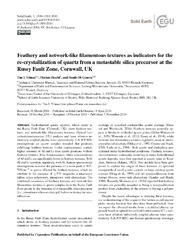Feathery and network-like filamentous textures as indicators for the re-crystallization of quartz from a metastable silica precursor at the Rusey Fault Zone, Cornwall, UK
Yilmaz, Tim I.
Duschl, Florian
Di Genova, Danilo
7, 6: 1509 - 1519
DOI: https://doi.org/10.5194/se-7-1509-2016
Persistent URL: http://resolver.sub.uni-goettingen.de/purl?gldocs-11858/7040
Persistent URL: http://resolver.sub.uni-goettingen.de/purl?gldocs-11858/7040
Yilmaz, Tim I.; Duschl, Florian; Di Genova, Danilo, 2016: Feathery and network-like filamentous textures as indicators for the re-crystallization of quartz from a metastable silica precursor at the Rusey Fault Zone, Cornwall, UK. In: Solid Earth, Band 7, 6: 1509 - 1519, DOI: 10.5194/se-7-1509-2016.
 |
Hydrothermal quartz crystals, which occur in
the Rusey Fault Zone (Cornwall, UK), show feathery textures
and network-like filamentous textures. Optical hotcathodoluminescence
(CL) analysis and laser ablation inductively
coupled plasma mass spectrometry (LA-ICP-MS)
investigations on quartz samples revealed that positions
exhibiting feathery textures (violet luminescence) contain
higher amounts of Al and Li than quartz positions without
feathery textures (blue luminescence), while concentrations
of Al and Li are significantly lower in feathery textures. Both
Al and Li correlate negatively with Si. Raman spectroscopy
investigations revealed the presence of a weak peak at 507–
509 cm����1 in quartz affected by feathery textures, which we
attribute to the presence of 5% moganite, a microcrystalline
silica polymorph, intergrown with chalcedony. The
combined occurrence of feathery textures and network-like
filamentous textures in quartz samples from the Rusey Fault
Zone points to the presence of a metastable silica precursor
(i.e., amorphous silica or silica gel) before or during the crystallization.
Statistik:
ZugriffsstatistikSammlung:
- Geologie [933]


